Back to: ZOOLOGY 300 Level
Welcome To Class!
Hey there, my awesome friend! I’m so glad to have you here today because we’re going to look at three different types of mammals: monotremes, marsupials, and placental mammals. These three groups show us how diverse the mammalian world is, especially in terms of reproduction and raising their young. Let’s explore how each of these mammals is uniquely adapted to its environment. Let’s get started!
Monotremes, Marsupials, And Placental Mammals
Monotremes: Egg-Laying Mammals
Monotremes are a very special group of mammals because they are the only mammals that lay eggs. This group includes animals like the platypus and echidna, found mainly in Australia and New Guinea.

- Reproduction: Female monotremes lay eggs, which they incubate in burrows or under their bodies. The mother then nurses her young by secreting milk through pores in the skin (they don’t have nipples like other mammals).
- Unique Features: Monotremes are quite unique because they combine features of both reptiles and mammals. For example, they have reptilian-like egg-laying and mammalian characteristics like producing milk. The platypus even has a duck-bill and webbed feet, which are adaptations for its semi-aquatic lifestyle.
Marsupials: Pouch-Bearing Mammals
Marsupials, like kangaroos, koalas, and wombats, are mammals that give birth to relatively undeveloped young, which then continue their development in a pouch on the mother’s body. These animals are mainly found in Australia, though some marsupials, like opossums, are found in the Americas.

- Reproduction: Female marsupials give birth to small, underdeveloped offspring. After birth, the young crawl into the mother’s pouch, where they latch onto a nipple and continue to grow until they are fully developed.
- Unique Features: The pouch provides a safe environment for the young to continue developing outside the womb. Marsupials have short gestation periods, meaning their babies are born at a very early stage, but their development continues in the pouch.
- Examples: Kangaroos are known for their powerful hind legs, which they use for hopping across vast distances in search of food. Koalas spend most of their time in eucalyptus trees, feeding on leaves and sleeping for most of the day.
Placental Mammals: The Most Common Mammals
Placental mammals are the most diverse and widespread group of mammals. This includes everything from humans to elephants, lions, and even whales. These mammals are called placental because they have a placenta that allows the embryo to develop inside the mother’s body before birth.

- Reproduction: Female placental mammals carry their young inside the uterus, where the developing fetus is nourished by the placenta. The placenta provides oxygen and nutrients to the developing young and removes waste products. Once the fetus is fully developed, it is born.
- Unique Features: Unlike monotremes and marsupials, placental mammals have longer gestation periods and give birth to much more developed offspring. The placenta allows the young to grow for longer inside the mother, which means they are generally more independent once born.
- Examples: Humans, dogs, and whales are all placental mammals. Elephants, for example, have a long gestation period of around 22 months, one of the longest in the animal kingdom.
Summary
- Monotremes: These egg-laying mammals, such as the platypus and echidna, are a mix of reptilian and mammalian traits, with no nipples and milk secreted through skin pores.
- Marsupials: These mammals give birth to underdeveloped young, which continue to develop in a protective pouch. Examples include kangaroos, koalas, and wombats.
- Placental Mammals: These mammals give birth to fully developed young after a longer gestation period, with the help of a placenta that nourishes the fetus. Humans, lions, and whales are examples.
Evaluation
- What makes monotremes different from other mammals? Give an example.
- Describe how marsupials care for their young after birth.
- How does the placenta benefit placental mammals during reproduction?
- Give two examples of placental mammals and explain how their reproductive process differs from that of marsupials.
- Why do you think the pouch is an important adaptation for marsupials?
Well done, my friend! You’ve just learned about three incredible groups of mammals and their unique ways of reproducing and raising their young. It’s amazing how nature finds so many ways to solve the same problem — how to ensure the survival of the next generation. Keep up the great work, and remember: Afrilearn is here to help you soar as you continue your learning adventure. See you in the next lesson!
